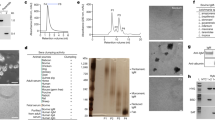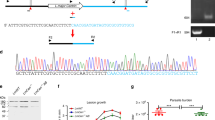Abstract
The severity of disease caused by infection with Leishmania major depends critically on the genetics of the host. Early induction of T helper (Th)1-type immune responses in the resistant C57BL/6 mice and Th2-type responses in the susceptible BALB/c mice are thought to determine cure or disease, respectively. We have previously mapped three host response loci in a genetic cross between C57BL/6 and BALB/c mice, and here we show definitively the involvement of these loci in disease severity using animals congenic for each of the loci. Surprisingly, in the late stage of infection when the difference in disease severity between congenic and parental mice was most pronounced, their cytokine profile correlated with the genetic background of the mice and not with the severity of disease. This indicates that the loci that we have mapped are acting by a mechanism independent of Th phenotype.
This is a preview of subscription content, access via your institution
Access options
Subscribe to this journal
Receive 6 digital issues and online access to articles
$119.00 per year
only $19.83 per issue
Buy this article
- Purchase on Springer Link
- Instant access to full article PDF
Prices may be subject to local taxes which are calculated during checkout





Similar content being viewed by others
References
Handman E, Sjölander A, Ilg T et al. Host–parasite interactions in leishmaniasis. Immunologist 2000: 8: 42–44.
Walton BC, Valverde L . Racial differences in espundia. Ann Trop Med Parasitol 1979; 73: 23–29.
Greenblatt CL . The present and future of vaccination for cutaneous leishmaniasis. Prog Clin Biol Res 1980; 47: 259–285.
Doffinger R, Dupuis S, Picard C et al. Inherited disorders of IL-12- and IFN-gamma-mediated immunity: a molecular genetics update. Mol Immunol 2001; 38: 903–909.
Goswami T, Bhattacharjee A, Babal P et al. Natural-resistance-associated macrophage protein 1 is an H+/bivalent cation antiporter. Biochem J 2001; 354: 511–519.
Vidal SM, Malo D, Vogan K, Skamene E, Gros P . Natural resistance to infection with intracellular parasites: isolation of a candidate for Bcg. Cell 1993; 73: 469–485.
Mock B, Blackwell J, Hilgers J, Potter M, Nacy C . Genetic control of Leishmania major infection in congenic, recombinant inbred and F2 populations of mice. Eur J Immunogen 1993; 20: 335–348.
Blackwell JM . Genetic susceptibility to leishmanial infections: studies in mice and man. Parasitology 1996; 112: S67–S74.
Beebe AM, Mauze S, Schork NJ, Coffman RL . Serial backcross mapping of multiple loci associated with resistance to Leishmania major in mice. Immunity 1997; 6: 551–557.
Roberts LJ, Baldwin TM, Curtis JM, Handman E, Foote SJ . Resistance to Leishmania major is linked to the H2 region on chromosome 17 and to chromosome 9. J Exp Med 1997; 185: 1–6.
Roberts LJ, Baldwin TM, Speed TP, Handman E, Foote SJ . Chromosomes X, 9, and the H2 locus interact epistatically to control Leishmania major infection. Eur J Immunol 1999; 29: 3047–3050.
Lipoldova M, Svobodova M, Krulova M et al. Susceptibility to Leishmania major infection in mice: multiple loci and heterogeneity of immunopathological phenotypes. Genes Immun 2000; 1: 200–206.
Locksley RM, Heinzel FP, Sadick MD, Holaday BJ, Gardner KJ . Murine cutaneous leishmaniasis: susceptibility correlates with differential expansion of helper T-cell subsets. Ann Inst Pasteur Immunol 1987; 138: 744–749.
Solbach W, Laskay T . The host response to Leishmania infection. Adv Immunol 2000; 74: 275–317.
Biedermann T, Zimmermann S, Himmelrich H et al. IL-4 instructs TH1 responses and resistance to Leishmania major in susceptible BALB/c mice. Nat Immunol 2001; 2: 1054–1060.
Sacks D, Noben-Trauth N . The immunology of susceptibility and resistance to Leishmania major in mice. Nat Rev Immunol 2002; 2: 845–858.
Lavebratt C, Apt AS, Nikonenko BV, Schalling M, Schurr E . Severity of tuberculosis in mice is linked to distal chromosome 3 and proximal chromosome 9. J Infect Dis 1999; 180: 150–155.
Abbas AK, Murphy KM, Sher A . Functional diversity of helper T cells. Nature 1996; 383: 787–793.
Launois P, Gumy A, Himmelrich H et al. Rapid IL-4 production by Leishmania homolog of mammalian RACK1-reactive CD4(+) T cells in resistant mice treated once with anti-IL-12- or IFN-gamma antibodies at the onset of infection with Leishmania major instructs Th2 cell development, resulting in nonhealing lesions. J Immunol 2002; 168: 4628–4635.
Kropf P, Etges R, Schopf L et al. Expression of Th2 cytokines and the stable Th2 marker ST2L in the absence of IL-4 during Leishmania major infection. Eur J Immunol 1999; 29: 3621–3628.
Markel P, Shu P, Ebeling C et al. Theoretical and empirical issues for marker-assisted breeding of congenic mouse strains. Nat Genet 1997; 17: 280–284.
Wakeland E, Morel L, Achey K, Yui M, Longmate J . Speed congenics: a classic technique in the fast lane (relatively speaking). Immunol Today 1997; 18: 472–477.
Weil MM, Brown BW, Serachitopol DM . Genotype selection to rapidly breed congenic strains. Genetics 1997; 146: 1061–1069.
Roberts M, Mock BA, Blackwell JM . Mapping of genes controlling Leishmania major infection in CXS recombinant inbred mice. Eur J Immunogen 1993; 20: 349–362.
Wittwer CT, Herrmann MG, Moss AA Rasmussen RP . Continuous fluorescence monitoring of rapid cycle DNA amplification. Biotechniques 1997; 22: 130–131 134–138.
Hein J, Schellenberg U, Bein G, Hackstein H . Quantification of murine IFN-gamma mRNA and protein expression: impact of real-time kinetic RT-PCR using SYBR green I dye. Scand J Immunol 2001; 54: 285–291.
Heinzel FP, Sadick MD, Holaday BJ, Coffman RL, Locksley RM . Reciprocal expression of interferon-γ or interleukin-4 during the resolution or progression of murine leishmaniasis. Evidence for expansion of distinct helper T cell subsets. J Exp Med 1989; 169: 59–72.
Szabo SJ, Dighe AS, Gubler U, Murphy KM . Regulation of the interleukin (IL)-12R b2 subunit expression in developing T helper 1 (Th1) and Th2 cells. J Exp Med 1997; 185: 817–824.
Himmelrich H, Parra-Lopez C, Tacchini-Cottier F, Louis JA, Launois P . The IL-4 rapidly produced in BALB/c mice after infection with Leishmania major down-regulates IL-12 receptor B2-chain expression on CD4+ T cells resulting in a state of unresponsiveness to IL-12. J Immunol 1998; 161: 6156–6163.
Mosmann TR, Cherwinski H, Bond MW, Giedlin MA, Coffman RL . Two types of murine helper T cell clone I. Definition according to profiles of lymphokine activities and secreted proteins. J Immunol 1986; 136: 2348–2356.
Chatelain R, Mauze S, Coffman RL . Experimental Leishmania major infection in mice: role of IL-10. Parasite Immunol 1999; 21: 211–218.
Powrie F, Menon S, Coffman RL . Interleukin-4 and interleukin-10 synergize to inhibit cell-mediated immunity in vivo. Eur J Immunol 1993; 23: 3043–3049.
Belkaid Y, Hoffman KF, Mendez S et al. The role of interleukin (IL)-10 in the persistence of Leishmania major in the skin after healing and the therapeutic potential of anti-IL-10 receptor antibody for sterile cure. J Exp Med 2001; 194: 1497–1506.
Morris L, Troutt A, McLeod KS et al. Interleukin-4 but not gamma interferon production correlates with the severity of murine cutaneous leishmaniasis. Infect Immun 1993; 61: 3459–3465.
Handman E, Hocking RE, Mitchell GF, Spithill TW . Isolation and characterization of infective and non-infective clones of Leishmania tropica. Mol Biochem Parasitol 1983; 7: 111–126.
Mitchell GF, Curtis JM, Handman E, McKenzie IFC . Cutaneous leishmaniasis in mice: disease patterns in reconstituted nude mice of several genotypes infected with Leishmania tropica. Aust J Exp Biol Med Sci 1980; 58: 521–532.
Shaffer JP . Multiple hypothesis testing. Annu Rev Psychol 1995; 46: 561–576.
Chretien S, Dubart A, Beaupain D et al. Alternative transcription and splicing of the human porphobilinogen deaminase gene result either in tissue-specific or in housekeeping expression. Proc Natl Acad Sci USA 1988; 85: 6–10.
Simpson DA, Feeney S, Boyle C, Stitt AW . Retinal VEGF mRNA measured by SYBR green I fluorescence: A versatile approach to quantitative PCR. Mol Vis 2000; 6: 178–183.
Acknowledgements
This work was supported by the National Institute of Health, USA, the Howard Hughes Medical Institute and the National Health and Medical Research Council, Australia. Colleen Elso was supported by an Australian Postgraduate Award. We thank Joan Curtis and Lynn Buckingham for technical assistance.
Author information
Authors and Affiliations
Corresponding author
Rights and permissions
About this article
Cite this article
Elso, C., Roberts, L., Smyth, G. et al. Leishmaniasis host response loci (lmr1–3) modify disease severity through a Th1/Th2-independent pathway. Genes Immun 5, 93–100 (2004). https://doi.org/10.1038/sj.gene.6364042
Published:
Issue Date:
DOI: https://doi.org/10.1038/sj.gene.6364042
Keywords
This article is cited by
-
Efficacy of either orally administered fluralaner or topically administered imidacloprid/flumethrin for controlling Rhipicephalus sanguineus sensu lato premises infestations
Parasites & Vectors (2023)
-
Preneoplastic stromal cells promote BRCA1-mediated breast tumorigenesis
Nature Genetics (2023)
-
INHBA is a mediator of aggressive tumor behavior in HER2+ basal breast cancer
Breast Cancer Research (2022)
-
Identification of acetic acid sensitive strains through biosensor-based screening of a Saccharomyces cerevisiae CRISPRi library
Microbial Cell Factories (2022)
-
A doxycycline- and light-inducible Cre recombinase mouse model for optogenetic genome editing
Nature Communications (2022)



